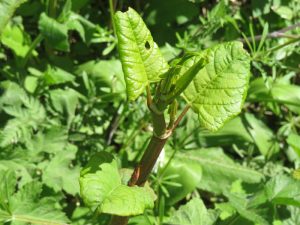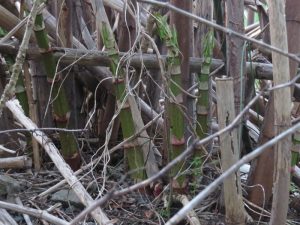Japanese knotweed problem?
Try this fantastic Japanese knotweed and beetroot relish.

Japanese knotweed (Fallopia japonica syn Polygonum cuspidatum) is an infamous, non-native, invasive plant. It can cause great damage to delicate eco-systems. But how many people know it is also a tasty edible with remarkable medicinal qualities?
There are many things you can do with this plant, such as turning it into this super japanese knotweed and beetroot relish. Harvesting knotweed for food could be a great way of helping to deal with it in your local area. (More on this in an upcoming blog)
Japanese knotweed is a perennial member of the rhubarb, buckwheat, and dock family (Polygonaceae). It re-appears each year aorund this time of year from a large, thick woody rootstock, sending up numerous tall shoots. These look a little like bamboo stems, with the addition of large, roughly shield-shaped leaves, which have a distinctive flat base and a long leaf stalk.

This plant was formerly popular in borders in large gardens, but it fell out of fashion and was then carelessly disposed of, helping it establish and spread around the country, long before we knew quite how invasive it was.
With an ability to re-establish from shards of root, or even the swollen nodal points of its stems during peak growing season, Japanese knotweed has taken over in some habitats, negatively impacting on our native flora, which it eeasily out competes.
It particularly likes river and canal banks, where temporarily dislodged pieces of the plant, disturbed by floods or landslides can take root as soon as they hit dry land again. Its rapid growth rate means the plant can establish itself in no time at all.

Japanese knotweed produces masses of flowers in the late summer, which the bees adore, but thankfully, the flowers fail to produce viable seed in our climate.
It wont be that difficult to find knotweed once you recognise it. So, once you are sure how to identify it, you can now have a go at turning the malicious, delicious!
Picking Japanese knotweed.
Make sure you are picking from a patch of knotweed that isn’t sprayed with herbicides. Landowners will employ heavy machinery and pesticides to deal with large infestations. It’s best to find some well off the beaten track.

The best shoots for eating are the young new emerging growth you see in April and May. Yes you could use the very tops of the stems a little later in the year for wine, but for use as a vegetable or a sweet, the new shoots are what you want.
Cut at just above ground level or around 6-8 inches below the growing tip. As long as that shoot is fresh and tender, you are good to go!
Word of warning…This japanese knotweed and beetroot relish is seriously good!
How to make japanese knotweed and beetroot relish
Ingredients: (These are all approximate – feel free to add other ingredients. This made about 600 g of relish)

Good big bunch of beetroot
About 15 or so decent sized young knotweed shoots
japanese knotweed shoots are typically cut to about 6-8 inches for cooking
1 large onion
4 cloves garlic
Approx 300 ml vinegar (white wine or cider vinegar)
300 grams soft brown sugar
Spices, including:
Cumin, coriander, cayenne pepper, fenugreek, cloves, all spice, cinnamon, 2 bay leaves, salt and pepper
Suggested method:
Peel and chop the beetroot into small dices approx 1cm (you could dry salt the beetroot at this stage to ensure a crunch in the matured finished product.
Bring the beetroot in water to the boil for 20 minutes or so, then strain and set aside (cook for longer if you like a softer relish. I like a little bit of bite in my veg!)
Peel and finely chop the onion and garlic.
Chop the knotweed shoots into small rings.
Add the beetroot, onion, garlic, spices (in a muslin bag if using whole spices), vinegar and sugar into a pan and bring to the boil. Turn down to a simmer and reduce the mixture for a while, until is starts to thicken a little. Carry on simmering.
Add the knotweed shoots to the pan, and continue to simmer. Keep reducing until a consistency where you are able to bring the wooden spoon across the bottom of the pan, revealing the base. The beetroot should still have some firmness or ‘bite’, rather than be completely soft.

Add some salt and pepper to taste.
The mixture should be pretty thick but able to slowly pour of the spoon. You are after a similar consistency to a good jam.
Immediately decant into sterilised jars. Label and store in a cool place.
Enjoy this japanese knotweed and beetroot relish with whatever you fancy!
This recipe was first published by our resident forager and wild foods educator Chris Hope in 2017, on his foraging resources website Wild Plant Guide.
